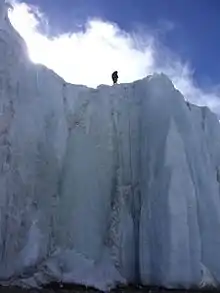Mount Kilimanjaro (/ˌkɪlɪmənˈdʒɑːroʊ/) is a dormant volcano 5,895 meters (19,341 ft) above sea level in the United Republic of Tanzania.
There are several routes by which to reach Kibo, or Uhuru Peak, the highest summit of Mount Kilimanjaro, namely: Marangu, Rongai, Lemosho, Shira, Umbwe and Machame.
Being one of the most popular mountains in the world, roughly 50,000[1] trekkers every year try to reach the summit of Mt Kilimanjaro. According to research published by the Climb Kilimanjaro Guide, the average summit success rate across all climbers and routes is 65%. However, summit success rate heavily depends upon what route is climbed, as routes vary considerably in terms of acclimatization profile and duration of the climb.
Trekking routes

Kilimanjaro has a number of official climbing routes. These are: Northern Circuit, Machame, Marangu, Rongai, Londorossi Lemosho, Umbwe, Shira, and Mweka (descent only).
Summary of routes
| Route | Description | Days | Length |
| Northern Circuit | Newest route on Kilimanjaro. Very low traffic due to very long time on the mountain, traverses nearly the entire mountain including the north side. Long route with great views. | 9 | 90 kilometres (56 mi) |
| Lemosho |
Long access drive, remote, less frequented forested traverse to Barafu, camping. | 8 (-1) | 56 kilometres (35 mi) |
| Machame |
Second most popular route. Forested traverse to Barafu. | 7 (-1) | 49 kilometres (30 mi) |
| Marangu |
Very popular (crowded). Gentle gradients and long sections up to 4700m (2.9 mi). Not a very scenic route as compared to Machame and Lemosho, comfortable but basic huts. The 6 day variant provides good time for acclimatization due to a rest day at Horombo Hut. | 6 (-1) | 64 kilometres (40 mi) |
| Rongai |
Long access drive, remote, less frequented, some fine, wild, least scenic, camping. Good for acclimatization. | 5-6 | 65 kilometres (40 mi) |
| Umbwe |
Shortest and steepest route, very physically taxing and requires serious endurance. Dangerous route. | 6 (-1) | 37 kilometres (23 mi) |
Marangu Route

The Marangu Route (also known as the "Coca-Cola" route) is the easiest ascent of Kilimanjaro.[2] Climbs can be done over 6 days. It crosses The Saddle, a 5 kilometres (3.1 mi) wide, high-altitude, semi-desert that separates craggy Mawenzi from the main summit Kibo. From the summit, glaciers, screes, cliffs, afro-alpine moorland, and forests lead down to the cultivated foothills.
The Marangu route is a favorite of local tour operators as it is the shortest route and requires no camping gear to be carried. For this reason, it is often the cheapest option. Because of its short profile, the Marangu route has the lowest summit success rate out of any route.
Trekkers sometimes spend an extra day to acclimate to the altitude at Horombo Hut. Also, trekkers often start the final ascent to Uhuru Peak early from Kibo Hut, because the scree is easier to climb when frozen, and they get a dawn view from the crater rim.
Route Outline
- Trekkers drive to Marangu Gate and walk through the rain forest to Mandara hut (2,743 metres (8,999 ft)).
- They leave the forest and cross the open moor land to Horombo hut (3,760 metres (12,340 ft)).
- They tend to rest and have an acclimatisation day at Horombo Hut. They then take a day walk to Zebra Rocks or to Mawenzi Hut, although this day is optional.
- Trekkers then walk through moorland then alpine desert to "The Saddle" between the peaks of Mawenzi and Kibo. From here they take roughly an hour to reach Kibo hut (4,730 metres (15,520 ft)).
- They will often wake very early for a start for the summit on a steep scree up to Gillman's Point (5,681 metres (18,638 ft)), which is on the crater rim. They then continue around the rim (which takes around two hours for able climbers) to Uhuru Peak (5,895 metres (19,341 ft)), the highest point in Africa. After having summitted the peak, they descend to Kibo Hut and then down to the thicker air and relative warmth of Horombo hut.
- After the fact, they then descend back to the start, to Marangu gate.


References
- ↑ Apollo, Michal (2017-01-02). "The good, the bad and the ugly – three approaches to management of human waste in a high-mountain environment". International Journal of Environmental Studies. 74 (1): 129–158. Bibcode:2017IJEnS..74..129A. doi:10.1080/00207233.2016.1227225. ISSN 0020-7233. S2CID 113843846.
- ↑ Lopez, Stephanie (27 July 2016). "Marangu/Coca-Cola Route Kilimanjaro". Climbing Kilimanjaro. Retrieved 19 October 2017.